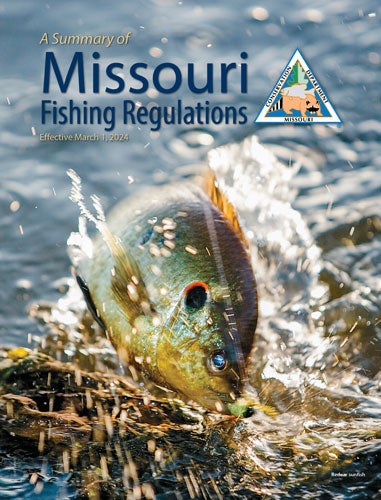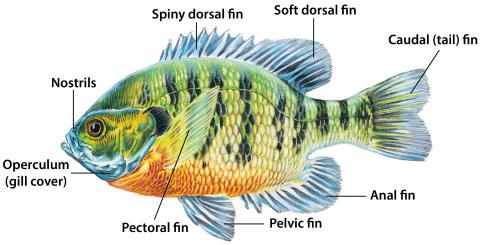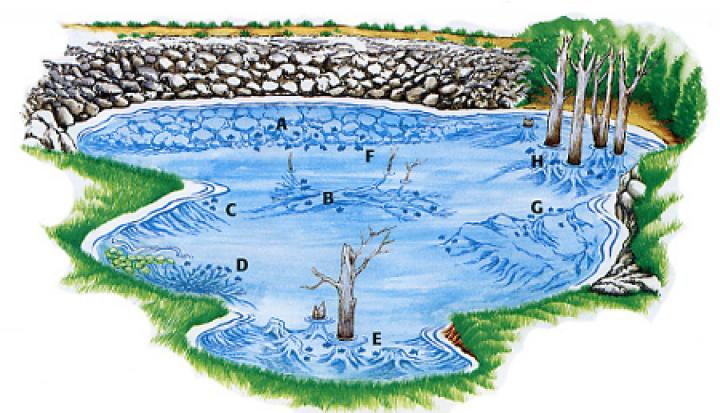Learn About Fish
Knowing how fish bodies work, how fish behave, and the different habitats they use throughout the year can improve your Missouri angling success.
Fish Senses
Built in Radar
The lateral line contains nerve endings along a row of pores on either side of a fish from gills to tail. The lateral line acts as radar, allowing the fish to detect the size, shape, direction and speed of objects.
Touch
Fish can detect minute temperature differences and can discriminate between hard and soft baits. Fish are more likely to hold a soft bait longer.
Sight
Fish are able to see well, but not in muddy water or low light. Out of the water, a fish's vision is very restricted.
Hearing
Water conducts sound better than air, and fish hear directly through the bones in their head. Noise on the bank or dock may attract or spook fish.
Taste
Most fish do not rely much on taste, but catfish and bullheads have taste buds over their entire bodies and fins.
Smell
Fish have a nasal sac to help them detect odor. Night feeders or fish that live in muddy water have a highly refined sense of smell.
Title
Fish Adaptations and Behaviors
Water temperature needs
Fish are cold-blooded, which means that their body temperatures are about the same as their surrounding environment. Because they don't produce body heat, fish must find and remain in water that they are adapted for.
Shape
A fish's streamlined shape helps it move through the water. The water also helps "float" fish; many species can make themselves lighter or heavier in the water by increasing or decreasing the amount of gas in their swim bladders.
How fish swim
A fish swims by alternately contracting muscles along each side, which causes its tail to sweep and propel the fish forward. The smaller fins assist with forward and backward movement, provide stability and steering and may help the fish brake.
Colors and patterns
Fish markings usually serve as camouflage. For example, fish that are found near rocks or weeds often have blotches or bars on their sides. Many fish are dark on top and light beneath, making them more inconspicuous when viewed from above or below, respectively.
Scales
Most fish have scales, which are embedded into the skin and are arranged in overlapping rows. Scales may be thick and tough, as in the sunfish, or extremely small, as in trout. Catfish have a tough skin, instead of scales. Growth marks on scales reveal the age of fish, just as tree rings show the age of trees.
Life span
The life span of most of our game fish is about four to six years, but some of them live more than 10 years. Fish continue to grow in length and girth as they get older.
Grouped or solitary
Many fish swim in groups or schools; solitary fish may concentrate when a feeding opportunity presents itself.
Feeding patterns
Some fish wander constantly in search of food; others have narrowly defined home ranges and wait for food to come close enough to ambush.
Daily travel patterns
Fish often make regular daily movements between feeding and resting places, seasonal movements to summer and winter habitat and annual movements to traditional spawning areas. Many species travel long distances to spawn. Spawning activity concentrates fish and makes them easier to find and catch.
Fish might be found in water scarcely deep enough to cover their backs, or they might swim in unfathomable depths. They may scour the bottom, roll on the surface or hover anywhere between.
Each species of fish goes through different cycles at various times of the year and eats different foods. Spawning puts fish in one place, their need for cover another, and their tolerances of temperature and oxygen levels another. Individual and species needs and preferences present too complicated an equation for people or computers to master.
Nevertheless, anglers have been trying to figure out the intricacies of fish location since people used bone-fish hooks. The result: still no absolutes, but along the way the discovery of some pretty reliable indicators of fish location. Study the diagrams in the pond and river sections below for hints to fish location.
Title
Food
All living things need to remain near a food source and fish are no exception. Fish tend to concentrate where food is plentiful. Schools of minnows or other prey fish will attract larger fish to feed on them. Fish take advantage of many feeding opportunities, including hatching insects and migrating frogs.
Signs of small fish activity can lead you to fishing hot spots. Minnows darting above the surface are often trying to escape from larger fish. Numerous small fish in the shallows could mean that larger fish will later arrive to feed.
Title
Cover
Fish use cover to escape predators and as an aid in ambushing prey. Some fish spend most of their lives near cover; others move from cover only to feed.
Cover can be loosely defined as anything that will hide or protect the fish. Weeds, docks, brush, rocks and logs all provide cover, so do overhanging trees, cliffs or swimming platforms, which shade the fish and make them less visible to other fish, predatory birds and humans.
Much cover is visible. Weeds grow near the bank, fallen trees lean over the water, boat docks and swimming platforms rim the lake, flooded timber reaches above the water's surface and loose rock often line shorelines.
A lot of cover cannot be seen. Underwater rocks and sunken logs, as well as fish shelters of sticks, brush or Christmas trees that anglers have placed to attract fish can be found on many lake and river bottoms.
Title
Structure
Drop-offs, points, ridges and sandbars shape the beds of lakes and rivers. These structural elements often attract more fish than do flat or gently sloping bottoms.
You can find good places to fish from clues on land or in the water.
- Land points often extend into a lake
- A path between flooded timber indicates an old river channel
- A break in a wave pattern reveals an underwater island
- A weed edge tells where the water has become too deep to allow sunlight to penetrate to the bottom.
Title
Edges
Feeding fish seem to favor transition zones between different habitats. The edge of a weed line, for example, usually produces the most fish. In rivers, fish often feed near current breaks, where the flow is deflected or slowed. These are often visible from the surface.
Similarly, the break between muddy and clear water, the edges of main lake basins, the margin where mud bottom meets gravel bottom and drop-offs also attract active fish.
Title
Deep or Shallow?
Fish respond to both feeding opportunities and light levels. Generally, fish are in shallower water in low light and choppy conditions, and in deeper water when the sun is bright and winds are calm.
Fish are often shallower in the spring and early summer. Summer heat sends fish deeper to find cooler temperatures, but not to the bottom, where there is little oxygen. Fall fish tend to remain deep. Fish in ice-covered lakes often stay near the surface, especially in late winter.
Title
Day or Night?
Fishing can be good at any time. However, fish seem to prefer the low light conditions of morning and evening better than the bright sun of midday. Cloud cover creates a twilight of its own and may encourage fish to bite.
Catfish, bass, crappie and many other species of fish will bite day or night. In some clear lakes, fishing is better at night than during the day. Big fish seem to be less selective and easier to catch when it is dark.
Fishing at night is difficult even for experienced anglers. Beginning anglers can experiment with fishing at night by fishing during the evening and continuing to fish until after dark.
Title
Good Weather or Bad
Weather certainly affects fish, but not always in predictable ways. The following statements often prove true:
- Fishing is good before and during a gentle rain but poor during and after a thunderstorm.
- Warm fronts improve fishing, and the longer the front stays, the better.
- Cold fronts often reduce fish movements.
- A light to moderate wind is better than no wind. Fish will move to shallower areas to feed in windy conditions.
- Fishing is usually better where the wind blows into the shore than along protected shorelines.
- The best time to go fishing is whenever you safely can.
Title
Patterns
Patterning means using information you have learned from the fish to find more fish. We can assume whatever caused a fish to locate in one place would prompt others to be in similar places.
Catching a fish off a windswept point, for example, could mean that other fish will be located on that point and on similar points throughout the lake. What works for one fish often works for others of the same species.
Patterns may hold for a few hours or all day, or they may persist for weeks. Some patterns repeat themselves year after year. Experiment until you discover a pattern then use that pattern to catch more fish.
Title
Where in a Pond
Title
Where in a River

























